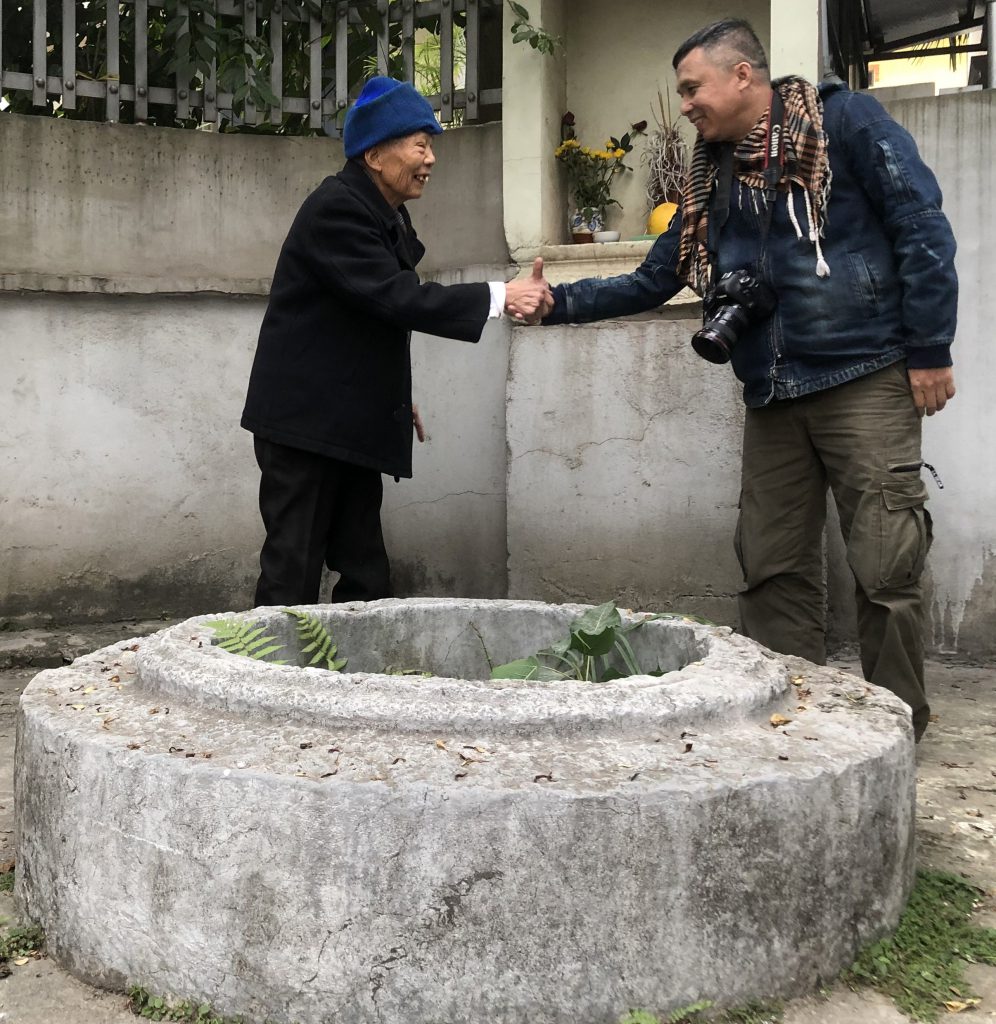Giang Le
“Some afternoons, I drive away from Hanoi to a Northern village, just to take photos and sit beside a well, finding happiness in that simple act,” said photographer Le Bich (Bich Gieng). On a rainy afternoon in Hanoi, sitting in the small lane of Hang Chi, he shared his passion for Vietnam’s old wells.

A well down an alley
An unexpected off-season rain brought a chill to Hanoi. The long and seemingly endless Hang Chi Alley became even more desolate. At the end of this alley lies an ancient well – one of 20 in Hanoi and among the 300 wells that Le Bich has photographed across Vietnam. Hang Chi Well is recognized as a National Heritage site, but like many of the city’s nostalgic spaces, it is still used by the locals. People still use its water for laundry. The nearby cafe becomes busier whenever Le Bich visits to take pictures, as journalists and cameramen often accompany him. The cafe, conveniently named Cafe Gieng, is easy to remember.
Le Bich said that nowadays, with tap water widely available, well water is seldom used for drinking or cooking. The water in the wells of the old quarters isn’t as clear. Interestingly, there’s a place in Hanoi where the well water remains crystal clear and refreshingly cool, but strangely, it’s rarely used.
“Can you believe it, there are ancient wells in the Imperial Citadel of Thang Long that still yield incredibly cool and clear water?” shared Mr. Bich. “There are wells yet to be excavated here, so historians usually estimate that there are between 23 and 26 wells. What’s special about the wells in the Imperial Citadel is their age. Some excavated wells show two distinct periods: from the Dai La and the Ly Dynasty. The newer layer of bricks lies on top of the older one, like a continuous and cherished legacy from the past.”
There are various types of wells in the city. Occasionally, Le Bich receives calls from strangers wanting him to come and see a well on their property. There are old wells, and unique ancient wells, but they don’t have as many details and stories as village wells, which the photographer spends a lot of time observing and researching.

Rural wells
Le Bich showed me photos of rural wells with clear passion in his eyes. “Here is a well from Bac Ninh in the Quan ho village. This one is a beloved well in a temple in Hung Yen. And here and here, from Nam Dinh to Thai Binh.”
Rural wells have many stories thanks to an old belief that each well has a guardian deity. Each well’s deity is revered in a different way. In Hoi An, for example, many wells still have altars dedicated to these deities. Perhaps it’s for this reason that the dishes in Hoi An, like Cao Lau and My Quang, have a unique flavor.
The most notable well lies in Diem village, a Quan ho village in Bac Ninh. Locals claim that their exceptional singing talent comes from drinking the water from Ngoc Well, situated opposite Cung Temple in the village. Unlike typical round village wells, Ngoc Well in Diem village is square. Three sides form the well’s walls, while the remaining side holds steps. To descend into the well, one must navigate ten brick steps, four stone steps, and a final step made of ironwood at the water’s edge. While the well’s origins are unknown, it has never run dry. Its crystal-clear water reveals the deep natural rock layers down below. Annually, on the 3rd day of the 3rd lunar month, the people of Diem village ceremoniously clean Ngoc Well. A visit to this Quan ho village is incomplete without seeing Cung Temple and Ngoc Well.

Wells of the soul
Just spend an afternoon with Le Bich and you’ll understand the allure of Vietnam’s old wells. They may seem simple, yet they are brimming with stories. It’s a mystery why the Gian Festival in Xuan Dinh, Tu Liem, Hanoi highlights the ritual of fetching water from an ancient well believed to date back to the time of the Trung Sisters. After the village elders conduct a water-requesting ceremony, a group of strong young men in red shirts carry the water using brightly painted yokes. They run throughout the village, entering homes as they wish. It’s believed that houses visited by the water-bearers will be blessed with good fortune.
The belief in the luck that wells bring is even stronger in Truong Yen village, Vinh Phuc. Mrs. Truc, an 80-year-old resident of the village, shared an amusing tale with Le Bich: “In the old days, Yen Truong village had 99 naturally formed wells. It was said that these were the hoofprints left by Saint Giong’s horse as he passed through the village.” The people of Yen Truong village still claim that if a village had 100 wells, a local from that village would become king. Naturally, they then lament that their village has only 99 wells.
There are many stories about Vietnam’s wells, but one that particularly struck me was about a photographer who drove back to his hometown just to see and take photos of its wells to alleviate his homesickness. “The scene of two boys happily chatting beside a well, with an ancient banyan tree and the village communal house in the distance, was mesmerizing, almost like stepping into a Vietnamese fairytale,” remembered Bich Gieng.
You can listen to Le Bich telling stories about Vietnam’s ancient wells on the podcast “Fly out one day” in the Music section on your personal entertainment screen on Vietnam Airlines’ flights. “Fly out one day” is also available 24/7 on the Heritage website, the Heritage fanpage, and the Vietnam Airlines Spotify channel.










